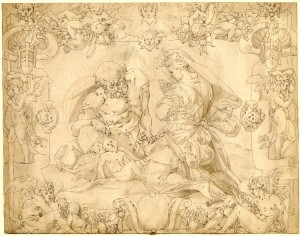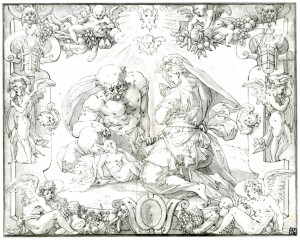c. 1538
|
D.75A. London, British Museum, no. 1863-1-10-6. Pen and brown black ink, the ink of the rays above and on the ground more brown, and gray brown wash over faint traces of black chalk, 28 x 35.8, all sides trimmed, cutting the image all around, and the inscription at the lower edge cut around; wm.? Inscribed in ink at the lower center: BAR [the B backwards] above the date 1567; also possibly inscribed 25 or 2F in the lower left corner. LITERATURE: Kusenberg, 1931, 148, no. 5, 168, under F.H.V, Anon. 14, as by Boyvin, with another version in the Bibliothèque Nationale. He believed that the monogram may stand for Renatus Boivinus Adeguaensis Lutetiae. Popham, 1939, 85, probably the drawing he said is signed by Boyvin. Levron, 1941, 62, no. 29, as signed by Boyvin. Carroll, 1987, 46, 328-329 and n. 1, under no. 103, as a copy of a lost drawing by Rosso of around 1538. |
|
D.75B. Paris, Bibliothèque Nationale, B.5 réserve, Dessins de l’École de Fontainebleau, Vol. I, no. 29. Pen and ink and brown wash over traces of black chalk, 27.3 x 35.3, all sides trimmed, cutting off parts of the image especially at the bottom; wm.? PROVENANCE: Bibliothèque Sainte Geneviève, Paris (Lugt 2259, 2352). LITERATURE: Kusenberg, 1931, 148, no. 7, and under no. 5, 168, under F.H.V, Anon. 14, as by Boyvin, after Rosso, and for the etching attributed to the former; another version in the British Museum. Levron, 1941, 63, no. 30, as Boyvin. Carroll, 1987, 46, 328-329, and n. 1, under 103, as a copy of a lost drawing by Rosso of around 1538. |
|
D.75C. Los Angeles, Lorser Feitelson and Helen Lundberg Feitelson Arts Foundation. Pen and ink and wash possibly over traces of black chalk, 28.8 x 36.3, possibly cut slightly at the top; laid down; wm.? Inscribed in ink in the lower middle of the mount: Rosso. On the back of the mount: in the lower right corner, the Feitelson mark, and above, in pencil, cc114; also in pencil: ACQ . 8-13-73 above AM [Alister Mathews], 139-10=67, and 648. PROVENANCE: Sir Joshua Reynolds (Lugt 2364); Alister Mathews (see above). LITERATURE: Carroll, 1987, 46, 328-329, and n. 1, under no. 103, as a copy of a lost drawing by Rosso of around 1538. As seen on a website on August 31, 2011, the Federal Bureau of Investigation has entered this drawing in its National Stolen Art File (NSAF). |
These three drawings copy a single lost drawing, although it is probable that the London drawing is derived from the one in Paris (see below). The Feitelson drawing is the most complete in showing a frame around the oval medallion at the bottom, as in the anonymous etching of this composition (see below), and part of a scene within the oval with a male nude seen from the back, his left arm possibly raised and his right lowered, his right hand touching something (an animal standing on its hind legs?).
The central image of the Holy Family is closely related to Rosso’s Pietà in the Louvre (Fig.P.23a). The Child reclines quite as Christ does in that painting, the Virgin’s abundant and richly folded drapery closely resembles that of the Magdalen and of St. John in the same picture, the long and extended piece of the Virgin’s headdress is almost identical to the lengths of such material covering the heads of the Virgin and one of the other Maries in the background of the Pietà, and the Virgin’s left foot is shaped and posed almost exactly like St. John’s in that painting. Compositionally as well, with its grand adult figures framing front and back the Child reclining on a diagonal between them, the Holy Family resembles the Pietà. In their largeness, the Virgin and Joseph also recall the figures in Rosso’s Enlightenment of Francis I in the Gallery of Francis I (Fig.P.22, VII S a). All of the motifs of the framing cartouche except the image of the Trinity resemble, but do not copy exactly, motifs in the gallery: the winged nudes playing wind instruments are similar to those on the West Wall (Fig.P.22, WestWall, a), the garlands of fruits and vegetables can be found throughout the decorations in that room, and the lanterns resemble the one at the lower right of the Cleobis and Biton wall (Fig.P.22, V S a). The various kinds of strapwork in the Holy Family are quite like those in the gallery.
Although the setting of a religious scene in a cartouche is not found elswhere in Rosso’s surviving work, the relation of them in the Holy Family appears to be an original aspect of this work and not the result of a later compositor. The motifs of the frame are wholly appropriate to the central image. Furthermore, the symbol of the Trinity in the frame sheds a radiance that enters the area of the central image, bringing together both parts of this design. Nothing of this kind can be found in the gallery, suggesting that its appearance in the Holy Family is due to Rosso’s originality and not to someone else extrapolating from his work.
Graphically, the three drawings are similar to Rosso’s Pandora and Her Box (Fig.D.67a), with its comparable long hooked lines, rows of dots, and several layers of wash. The draughtsmanship of all three copies is less freely executed, but the penlines indicating the radiance from the symbol of the Trinity show something of the same swiftness of the diagonal lines streaming from the center of the Pandora drawing. The more studied draughtsmanship of the Holy Family drawings also recalls that of the Throne of Solomon (Fig.D.34). But as much as the three drawings resemble Rosso’s, none is sufficiently precise or vigorous to be recognized as by Rosso himself. They must be copies of a lost drawing by Rosso, although the one in London is probably derived from the copy in Paris.1
So similar is the Holy Family to Rosso’s Pietà in the Louvre that the lost drawing must have been done about the same time, around 1538. The copies almost certainly describe what would have been executed finally as a fresco – the center part – surrounded by stucco. Having the symbol of the Trinity above the central figures suggests that the original drawing may have been made for the chapel of the Trinitarians at Fontainebleau.2
The upper left volute of the ornament at the bottom center appears in the lower right corner of the Design for the Stucco Frame of an Oval Picture (Fig.D.57).
PAINTED COPY: Milan, Carlo Pizzetti Collection (Fig.Pizzetti). Panel, 29 x 37. Acquired in Rome as “School of Vasari.”3 Formerly Vienna, Dorotheum, Miethke Sale, 12-19 June 1933, no. 141, P1. 9, as oil on panel, 27 x 39, and as from the collection of Miss Mason, Kensington.
This painting, of the same size as the drawings, shows the entire composition uncut at the edges. The cartouche painted in color indicates, as does the picture’s size, that the picture was made from a drawing and not from a fresco surrounded by white stucco decoration. The medallion below, without any indications of an image, has a frame as in the Feitelson copy.
PRINT: Anonymous, E.153 (Fig.E.153). This etching, in reverse of the drawings, shows the entire scene uncut at the sides; it also shows Joseph with a full head of hair, a greater burst of light above, no bundle of wheat behind Christ, a convex center to the medallion below, as well as a few other minor alterations.
1 The draughtsmanship of the Paris drawing resembles in its slight unsteadiness the Allegory of Deceit also in the Bibliothèque Nationale (Fig.D.56) and the Design for a Covered Cup in the Victoria and Albert Museum (Fig.RD.22), both of which are inscribed Leonard Thierry. The Education of Achilles in the Bibliothèque Nationale (Fig.D.53) has a comparable feathery touch. Therefore it is possible that the Holy Family in Paris is by Thiry. Kusenberg and Levron believed that the Paris and London drawings are by Boyvin, but the monogram on the London copy does not necessarily indicate this, although it may. The date on this drawing could support an attribution of it to Boyvin, who was in Paris at this time. But the etching of this composition (see below) is not by Boyvin. The Paris drawing is by a different hand from those of the other copies and would have to date before the London drawing that seems to be copied from it. This relationship between the London and Paris copies is indicated not only by the lack of a frame around the oval medallion at the bottom of the cartouche but also by the description of the drapery behind Joseph that is executed entirely in wash, while the Feitelson drawing includes the pen outlines and dots of the lost original. The washes of the Paris copy are crisper than those of the London drawing, indicating that the latter copies the former.
2 Binenbaum and Pressouyre, 1972, 48, pointed out that in the view of the château at Fontainebleau under the Venus and Minerva in the Gallery of Francis I (Fig.P.22, I N g), the bell tower of the Chapel of the Trinity can be seen at the far left. Dimier, 1925, 7, 33, and Blunt, 1973, 54, also mention this chapel. It was torn down under Henry II (see Pressouyre, 1974, 25-26, 28, 31, n. 29). There was also an Altar of the Trinity in Notre Dame in Paris, also called the “autel des ardents,” for the vaults above which Rosso made some plans in 1537 (see L.54). But it seems unlikely that the Holy Family was planned to be so large that it would have been executed on the vaults of a church. The shape of the image also does not seem related to the vaults of a gothic church (see also L.55-L.58).



